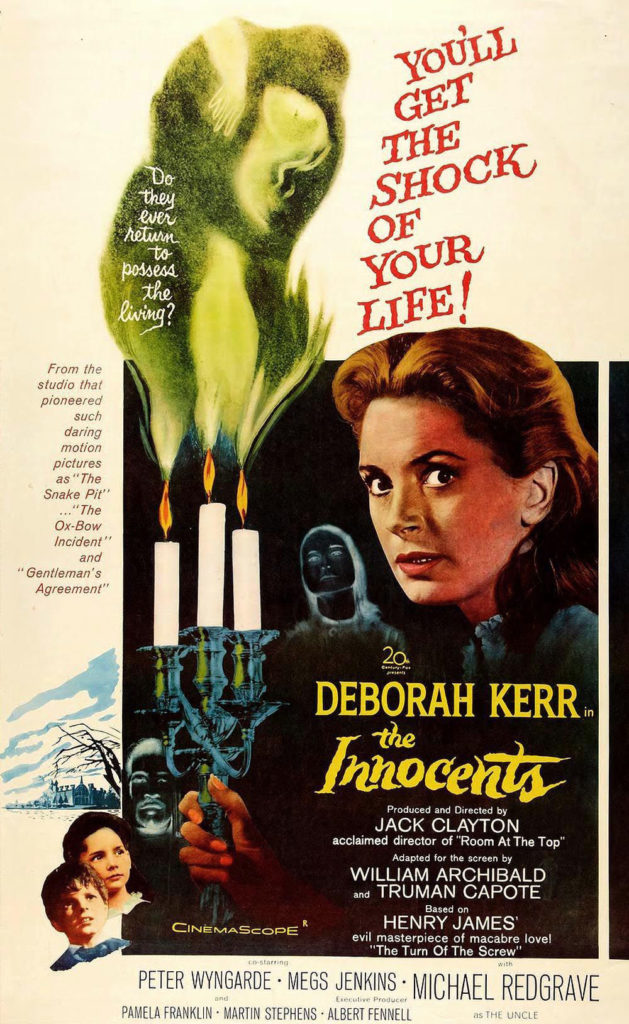The Innocents, the 1961 film from director Jack Clayton and screenwriters William Archibald, John Mortimer, and Truman Capote, is an adaptation of Archibald’s stage play, which itself is an adaptation of Henry James’s novella, The Turn of the Screw.
The film follows the trials and tribulations of one Miss Giddens (Deborah Kerr), a governess hired by the most aloof and cold-hearted master to grace the silver screen (Michael Redgrave). He, through familial misfortune, has come to be the guardian of his young niece and nephew, and has set them up in his spacious mansion in the south of England. But, he doesn’t want anything to do with them. He lives the 19th century equivalent of a jet-setting lifestyle, spending his time abroad and in the company of lovely young ladies. He’s frank about not wanting the children, and so hires Miss Giddens to care for them, with firm instructions that he is never to be bothered about them, ever. He’s a real piece of work, but he’s never seen again after the opening scene.
Afterwards the film concerns itself strictly with what goes on at the country estate between Giddens, the children, Flora and Miles (Pamela Franklin and Martin Stephens), and the housekeeper, Mrs. Grose (Megs Jenkins). Miss Giddens entertains fantasies that her time with the children will be blissful, but it doesn’t take long for those dreams to be  shattered. She begins to see and hear things around the house and the grounds. She becomes convinced there are a pair of ghosts roaming the estate, and worries that they are targeting the children for some sort of possession or transference of consciousness. Whether any of this is happening or if it’s all in Miss Giddens’s head is a big question hovering over the film. Denouement may or may not provide an answer, depending on how the viewer interprets it.
shattered. She begins to see and hear things around the house and the grounds. She becomes convinced there are a pair of ghosts roaming the estate, and worries that they are targeting the children for some sort of possession or transference of consciousness. Whether any of this is happening or if it’s all in Miss Giddens’s head is a big question hovering over the film. Denouement may or may not provide an answer, depending on how the viewer interprets it.
Ambiguity is the central theme of the film. Miss Giddens spends her time in frantic confusion and fear. Mrs. Grose is mysterious, seeming to know more about the spirits possibly haunting the house than she is willing to admit. The children are the greatest ciphers of them all — mischievous, engrossed in their own world with its own rules, the presences of the adults around them merely tolerated, but not needed. A viewer is left to wonder if they have picked up on Giddens’s strained emotions and are plotting to push her over the edge for their own amusement. Then again, they may just be normal children. After all, the film is told from the perspective of Miss Giddens. We see what she sees. We are led to conclusions about the events in the plot by her reactions to them, not anyone else’s. There’s a profound amount of depth to the way the filmmakers handled the plot.
It’s also a good-looking film, shot in high-contrast black and white, and framed like still photographs. There aren’t that many shots throughout that are wasted or feel like they weren’t considered in detail. This type of cinematography was once common in film, but, even in the few films that shoot in black and white today, seems to be a lost art.
That makes The Innocents a bit of a museum piece, and not just for the way in which it was shot. The film hails from a different era, when attention spans were more tolerant of what could today be considered a plodding pace. This isn’t to say the film is slow. It’s slow compared to what audiences are used to today, and there is a difference.
The Innocents is heavy on story, not scares. There are some unsettling moments sprinkled here and there, but shocking the audience was never the intention of this film. That doesn’t stop it from being a classic ghost film.
